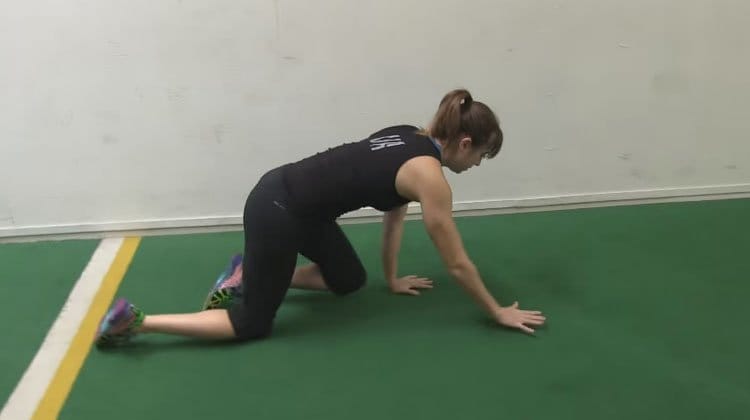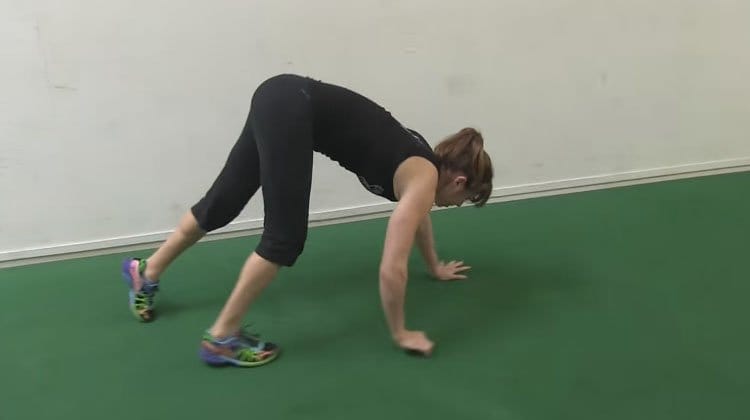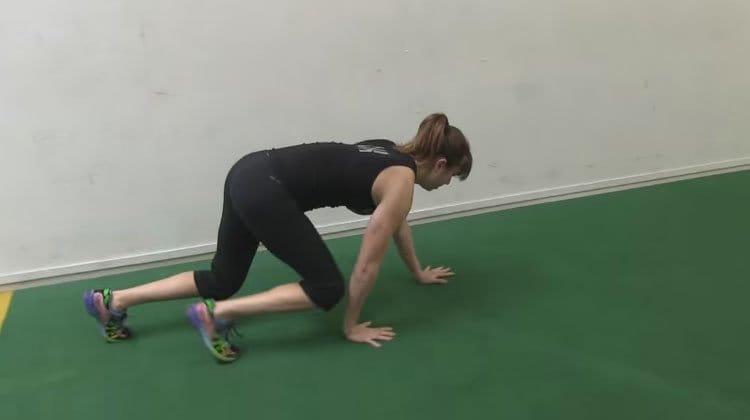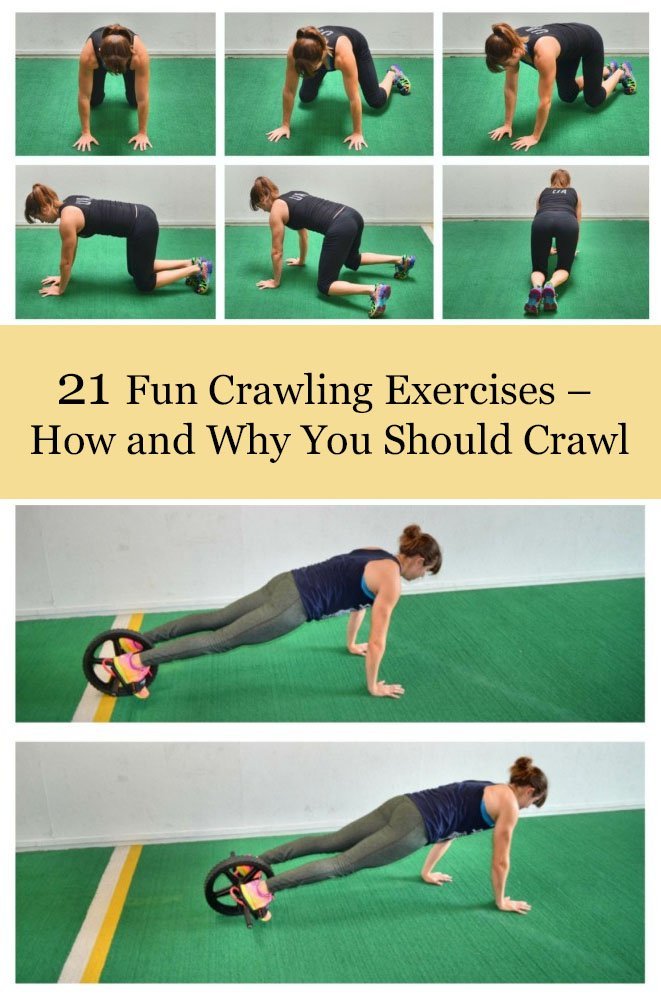Before you ran you walked and before you learned to walk, you learned to crawl. Crawling is an integral piece of our kinesiological development and it is usually the precursor activity to walking.
Crawling is an important functional milestone as it strengthens the muscles and connective tissues in and around the hands, wrists, elbows, shoulders, spine and hips. Furthermore, this weight-bearing quadruped motion also helps to stretch the hand ligaments, facilitating the development of the arches. Crawling also opens up the saddle joint at the base of the thumb – essential for being able to perform fine motor skills like holding cutlery, pens and pencils.
In adulthood, the increasing prevalence of sedentary lifestyles results in many of the deep stabilizing muscles becoming weak and ineffective at performing their functional role. Muscles and connective tissues weaken, posture changes and instability, dysfunction, tightness and pain usually follow, particularly during physical exertion.
This is why crawling exercises are as effective in adults as they are in infants and can help restore the optimal musculoskeletal health that has occurred as a result of a sustained period of inactivity.
More specifically, the benefits of crawling include:
- Improved bilateral coordination, required for many sporting activities, like throwing and kicking a ball or swinging a tennis racquet;
- Improved scapular stabilization, as each hand placement requires a stable shoulder in order to effectively transfer bodyweight;
- The development of optimum shoulder function; as the scapular stabilizers fix the scapular, the shoulder joint remains mobile which is how this region performs best;
- Develops strength at resisting contralateral rotation of the trunk – an essential component of core and spinal stability;
- Improves the proportional strength of the muscles, connective tissues and bones in the arms, shoulders, spine and hips. Many resistance based exercises develop strength disproportionately to antagonist and synergistic muscles. Crawling is a truly is a total body workout;
- An excellent calorie burner and a great cardio;
- Versatility – there are so many different variations of this exercise and today we’ll demonstrate 21 of them.
Once competence is developed with bodyweight, resistance can be added horizontally from a sledge or rope, or vertically from a rucksack/backpack to make the crawling motion even more challenging. This exercise is really only limited by the imagination and creativity of the exerciser or their fitness instructor.
Finally, crawling can be integrated into almost any workout to provide a different dimension to the session. It can be used as a specific exercise in a circuit, as transition movement between exercises or during rest periods, and as a competitive activity in a group exercise session/class.
Without further ado, here are 21 Crawling Exercises to strengthen your entire body while getting your heart rate up. These crawling exercises are great for everyone from the beginner to the advanced exerciser and can be regressed and progressed as necessary. Using a combination of these moves in your workouts, will help you get in a great cardio workout while working your body in every plane of motion.
1. Baby Crawl (0:15)

The baby crawl is a great place for beginners to start. By doing this crawl on your knees, you will teach your body the contralateral movement (opposite arm and opposite leg working together) while making it easier on your muscles to stabilize and move.
Baby Crawl starts with your hands and knees on the floor, with your knees under the hips and your hands under the shoulders. Simply step your right hand and left knee forward followed by your left hand and right knee. Mind not take too big a step forward, so that your opposite arm and opposite leg can work together. Brace your core as you are crawling forward.
To move backwards, we keep the same movement pattern, taking care not to take too big a step backward – otherwise you will overload your shoulders. You want to keep the movements small and tight and make sure your core is engaged the entire time.
Once comfortable with the contralateral movement, you can progress to the Traditional Bear Crawl.
2. Traditional Bear Crawl (0:32)

The Traditional Bear Crawl is similar to the crawl that many babies do with their limbs straighter and their butt up in the air. Because your butt is up in the air, the move is a little less challenging for the core than the Table Top Crawl that follows.
To do the crawl, start with your hands and knees on the floor, with your knees under the hips and your hands under the shoulders. Then push your butt back and up into the air. With your legs and arms essentially straight, step your left hand and right foot forward. Then step your right hand and left foot forward.
Keep crawling forward on your hands and feet with your butt up in the air.
To Bear Crawl backward, you may find that you move the same arm and the same leg to step back to move more quickly backward.
Keep your butt up in the air as you crawl forward and backward.
3. Table Top Crawl (0:46)

Be sure you are ready for the Table Top Crawl, as it requires more core strength and stability, better hip mobility and a decent amount of shoulder strength, especially to crawl backward. Additionally, because your knees are bent, your quads will be working hard as you crawl.
Start by setting up on your hands and knees with your knees under your hips and your hands under your shoulders. Flex your feet and lift up onto your toes. Now take a step forward with your left foot and right hand, keeping your knees close to the ground and your back flat. Brace your core so that your hips don’t wiggle a lot side to side as you crawl forward.
Next, step forward with your right foot and left hand and keep crawling forward, moving the opposite arm and opposite leg together. Take small steps and don’t allow your hips to wiggle and your butt to go up in the air.
To do this crawl backwards, we need to step back with the opposite arm and leg. Make sure you don’t get too spread out and keep your movement fluid – concentrate on short steps and keeping the knees close to the ground. Make sure to tense your core and keep your butt down.
4. Sideways Table Top Crawl (1:03) – The Sideways Table Top Crawl is a great way to work your core in the frontal plane of motion. Even though you are moving sideways, you are still performing a contralateral movement.
The position is same as the Table Top Crawl. We start with the hands close together and the feet about hip-width to shoulder-width apart. Now we step the left hand to the left so your hands are about shoulder-width apart as the right foot steps toward our left foot to bring our feet together.
Now step your right hand to meet your left hand as you move your left foot to the left so your feet are again about hip-width to shoulder-width apart. Keep stepping the opposite arm and the opposite leg out to the side and come back the other way by leading with the other hand and leg.
5. Circle Crawl (1:18) – With the Circle Crawl variation you focus on circling your hands and feet around a point beneath your belly button.
Warning: Do not circle your body around your hands!
You start by getting on your hands and knees. Flex your feet and lift up onto your hands and toes with your knees about under your hips and your hands under your shoulders. Now start to circle, stepping with the opposite hand and foot.
Imagine there is a string attaching your belly button to the ground as you circle. It’s advisable to put something on the ground under your belly button to give you a focus point so that you don’t start circling around your hands.
Complete a full circle one direction then switch and do a complete circle the other way. Remember you are crawling around in a circle with the opposite hand and foot working together. Keep your knees close to the ground as you circle and your core tensed.
Beginners may do the Circle Crawl on their hands and knees like with the Baby Crawl.
6. Crab Crawl (1:34) – The Crab Crawl is a fun and different way to crawl, but it can be harder on the shoulders and rotator cuff muscles so take care with this variation.
We start by sitting on the butt with the knees bent and feet flat on the ground. Place your hands behind you and lift your butt up off the ground, stepping the right hand forward towards the hip as you step your left leg out in front. Then step with our right foot and left hand. Leading with your feet, begin to move forward, keeping your butt up off the ground.
To crawl backwards, lead with your hands, reaching the right hand back as you move your left foot in closer to your glutes. Then your left hand will reach back as you bring your right foot in closer to your glutes.
Keep your butt up off the ground throughout the crawl!
7. Sideways Crab Crawl (1:53) – Real crabs walk sideways so the Sideways Crab Crawl is actually more nature like and a super fun crawl.
To do the Sideways Crab Crawl, assume the same position as in the Crab Crawl. Then lift your butt up off the ground and begin to move sideways. You will step to the right with your right hand and left foot and then your left hand and right foot. Just like with the sideways Table Top Crawl it is a contralateral movement.
Crawl to one side then come back facing the same way leading with the other hand and foot.
8. Gorilla Crawl (2:12) – The Gorilla Crawl is a great crawling variation to working up your legs and core. It can be challenging for many people because it requires a bit more hip mobility.
Start by standing with your feet wider than shoulder-width apart, then bend over and reach your hands out on the ground in front of you. Shift your weight forward to your hands on the ground and then jump your feet forward outside your hands.
Once you’ve jumped your feet close to outside your hands, you will again reach your hands out and place them in front of you on the ground before jumping your feet back outside your hands.
You might feel like your weight is a bit forward during this crawl, but do not stand up between reps. The more mobile your hips, the more you will be able to get your feet outside your hands.
9. Sideways Gorilla Crawl (2:26) – While the Sideways Gorilla Crawl requires less hip mobility, it can be difficult in terms of coordination because you are shifting your weight from your hands to your feet back to your hands as you move sideways.
Start in a crouch on the balls of your feet with your feet about hip-width apart. Then place your hands out to the left at about shoulder height. Shift your weight onto your hands and press off your hands as you jump your feet over to the left. As you land back in the crouch, shift your weight back to your feet as you lift your hands and place them again out to the left.
Again shift your weight to your hands and jump your feet past your hands to the left. Continue moving left. Then to come back right, reach your hands out to your right side and then jump your feet to the right.
As your feet land, shift your weight and lift your hands before reaching them to the right again.
Stay low in the crouch the entire time, pushing off your hands then feet then hands.
10. Inchworms (2:41) – Simply a great crawl to include in your warm up routine because it can help stretch your hamstrings, hips, abs and even your chest. If you have low back pain, this is a great crawling exercise to include in your routine.
To do the Inchworm, start standing with your feet together, then bend over and place your hands on the ground in front of you while keeping your legs straight.
Walk your hands out while keeping your legs straight until you are in the plank position. Then drop your hips toward the ground and arch back, pressing your chest out and keeping your arms straight. You can even look back and up toward the ceiling as you drop your hips and press your chest out.
Return to the plank position before you begin to walk your feet in, keeping your legs straight and pushing your butt up toward the ceiling. Walk your feet in as close to your hands as your flexibility allows.
Repeat walking your hands back out while keeping your legs straight. If you need to, you can even stand up between Inchworms.
Beginners may need to bend their knees a little as they perform the Inchworms. Try to stretch your hamstrings though as you walk out and back in.
11. Beginner Alligator (3:00) – The Alligator Crawl is a great exercise to engage your obliques. Advanced Alligator Crawl requires a lot of upper body strength, so beginners will want to start with this straight-arm variation.
Start in a high plank position with your hands under the shoulders and your body in a straight line from the head to the heels. Then step your right hand forward as you bring your left knee out and in toward your left elbow.
Next step forward with your left hand as you bring your right knee up to your right elbow.
Keep crawling forward, driving your knee in toward the outside of the same elbow as you keep your core engaged.
12. Advanced Alligator (3:15) – For the Advanced Alligator Crawl, you need to stay low the entire time, which is going to be harder on your shoulders, chest and triceps.
Start in the same position and movement as the Beginner Alligator, bringing the same knee into the same elbow as you step the other arm forward. However, instead of keeping your arms basically straight, you are going to crawl while holding near the bottom of a push up position.
Keep your body low and close to the ground as you step your right hand out and bring your left knee to the outside of your left elbow. Then step your left hand out as you bring your right knee into your right elbow. Engaging, isn’t it?!
13. Army Crawl (3:32) – With this Army Crawl variation, you will crawl forward on your forearms while keeping your body low and close to the ground.
This is another contralateral movement, so when you crawl you will step forward with your left forearm and right leg, then your right forearm and left leg. Try to stay as low to the ground as possible.
14. Crawl with Sit Through (3:45) – To make basic crawls more fun and challenging you can add in other movements while crawling around. One such movement for the Table Top Crawl is the Sit Through. The Sit Through is a great rotational core move to include with your crawls.
To do the Crawl with Sit Through, you will do the Table Top Crawl forward then perform a Sit Through to each side. Start by pausing during the Table Top Crawl position.
Rotate open toward the right and bring your left leg under and through toward where your right hand is. As you bring your left leg forward and through, lift your right hand. You should almost be sitting when you rotate through with your left hand down to support you. Now bring the left leg back through so you are back in the starting crawl position.
Next rotate to the left and kick your right leg through and forward as you lift your left hand. Bring the leg back through to the crawling position and then change the direction of your crawl. After crawling forward and performing a Sit Through to each side, crawl backwards.
Then perform a Sit Through to each side and move back to crawling forward. Try to move quickly as you crawl back and forth performing a Sit Through to each side before you change directions.
15. Crawl with Pull Through (4:03) – The Crawl with Pull Through is another great variation of the basic Table Top Crawl and recommended for all who sit at a desk all day as it works on glute activation and hip extension.
To do the Crawl with Pull Through, a sandbag works best although you can use a dumbbell or even a sledge hammer.
Place the sandbag on the ground and set up on your hands and knees with the sandbag behind your feet. Your hands should be under your shoulders and your knees should be under your hips. Now flex your feet and lift up onto your hands and toes.
Reach one hand back through your legs to grab the sandbag. As you reach back, sit your butt back toward your heels. Push off the balls of your feet and drive your hips forward to pull the sandbag up under your body and through overhead. As you pull the sandbag through, extend your hips and squeeze your glutes to help you power the pull.
Your hips should power the pull so that you can pull the sandbag up to your head or a little beyond.
Once you’ve pulled the sandbag, perform a Table Top Crawl up past the bag and sit your butt back again and reach through with the other hand. Pull the sandbag up and through.
Make sure to use a heavy enough bag that makes you feel challenged. If it doesn’t force you to use your glutes, the bag is too light. If you can throw the bag 10 feet out in front of you, the bag is also too light. Use a bag that you can only pull a little past your head at most.
16. Plank Walk (4:20) – The Plank Walk is one of the tougher crawling variations for the core and shoulders. You are essentially holding a Plank as you crawl forward and backward, which makes your abs work!
Start in a high plank position with your hands under your shoulders and your legs out straight behind you and your feet close together. Brace your abs and keep your body in a straight line from your head to your heels.
Take a small step forward, first with your right hand and left foot and then with your left hand and right foot. These should be very small steps that allow you to keep your core tight and your body in a straight line. Make sure your hips don’t sag and your butt doesn’t go up in the air.
To go backward, just reverse the crawl, again, keeping your steps small and the body in a straight line.
17. Sideways Plank Walk (4:37) – The Sideways Plank Walk variation is a great way to challenge your core and shoulders.
Start up in a high plank position with your hands under your shoulders and your legs out straight behind you, bracing your abs and keeping your body in a straight line from the head to the heels.
Step your right hand in close to your left as you step your left foot out so your feet are about hip-width to shoulder-width apart. Now step your left hand out so your hands are about shoulder-width apart as you step your right foot in so your feet are together.
Continue the lateral movement, bringing your feet together as you step your hands out wide before you step your feet out wide and your hands back together.
Make sure your butt doesn’t go up in the air or your hips sag as you crawl. Attempt to keep your hands under your shoulders as you crawl. If your hands creep out in front of your shoulders toward your head, it will put more strain on the shoulders.
18. Slider Crawl (4:53) – Another great variation of the Plank Walk is the Slider Crawl using Valslides or even towels or paper plates. The Slider Crawl is an advanced crawl that is core and shoulder intensive.
Start by placing your feet on the sliders and set up in a high plank position. Your hands should be under your shoulders and your feet should be together on the sliders, forming a straight line from head to toes.
Step forward with your left hand and then your right hand, dragging your legs behind you on the sliders. Brace your abs and keep your core tight so that your hips don’t wiggle as you crawl forward in the plank position.
To crawl backward, you will take small step backward with your hands, pushing your body back on the sliders. Make sure your body stays in a nice straight line as you push yourself backward.
19. Power Wheel Crawl (5:12) – The Power Wheel is and additional tool to advance the Plank Walk.
Warning: Do not use the Power Wheel if you haven’t mastered the Slider Crawl!
Place your feet in a Power Wheel and then turn over onto your hands and lift up into the high plank position. Brace your abs and set your body in a straight line with your hands under your shoulders.
Begin to walk, stepping forward with one hand and then the other as you drag your legs in the Power Wheel behind you. Keep your body in a straight line as you move forward and do not let your hips wiggle excessively side to side. Also, do not let your hips sag or your butt go up in the air as you crawl forward.
Take small steps forward with your hands then reverse the crawl and take small steps backward, pushing yourself backward on the Power Wheel. Maintain a straight line as you crawl backward.
20. Thor’s Hammer Crawl (5:31) – The next step in advancing your crawling exercises is by adding weight. You can push a sled, box or even a Sledge Hammer.
To do the Thor’s Hammer Crawl, place the sledge hammer flat on its side on the ground and your hands on top of the hammer.
Push the hammer down into the ground as you push it forward, running your knees in.
21. Thor’s Hammer Pull (5:48) – Once you’ve pushed the hammer down, you can crawl and pull it back to put it away. This crawl is essentially a reverse of the Crawl with Pull Through and can also be done with a sandbag instead of the hammer.
Start by placing the hammer on its side with the handle just in front of you while you are in the Table Top Crawl position. Reach forward and grab the hammer and pull it back to you as you hold the crawl position. If the hammer is heavy, you may need to sit your butt back as you pull the hammer or weight to you.
Now crawl backward until the handle is just beyond your head. Again reach forward and pull it back to you. You can either alternate arms or pull with one arm and then the other. After each pull, crawl backward so that the hammer is just beyond your head.
Enjoy your crawling and remember, babies might do it, but crawling is far from easy and is sure to challenge your entire core!
Source: redefiningstrength



